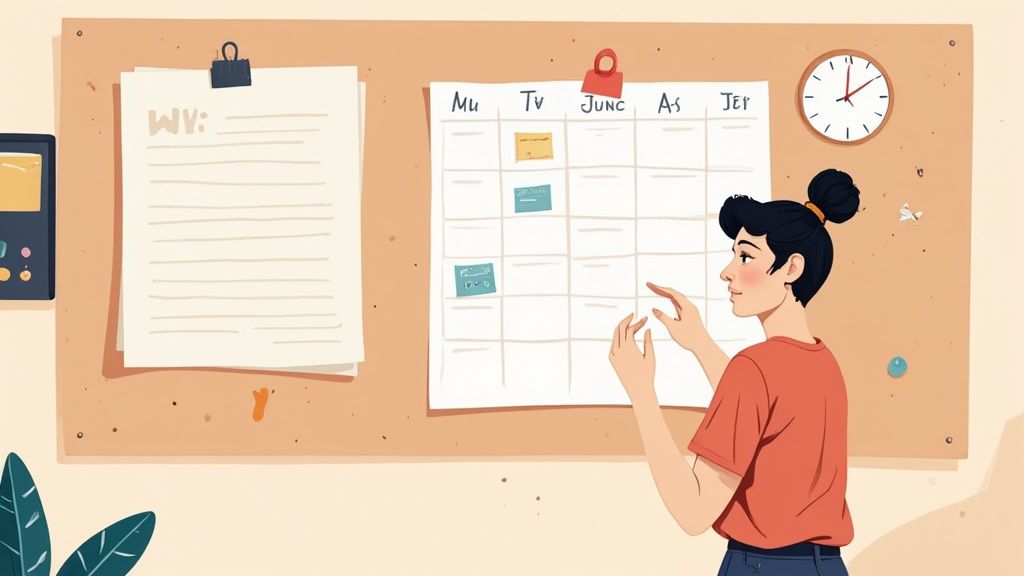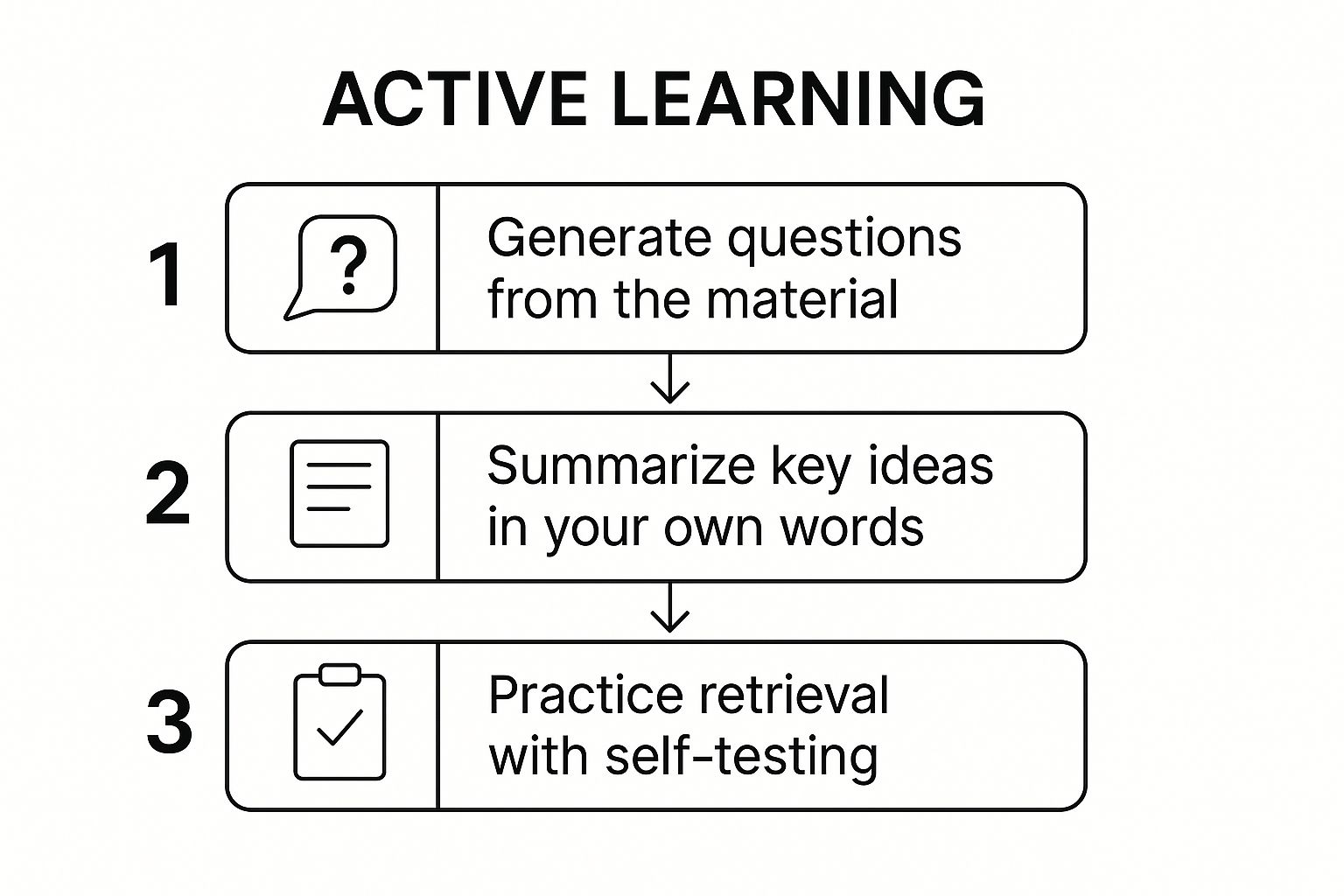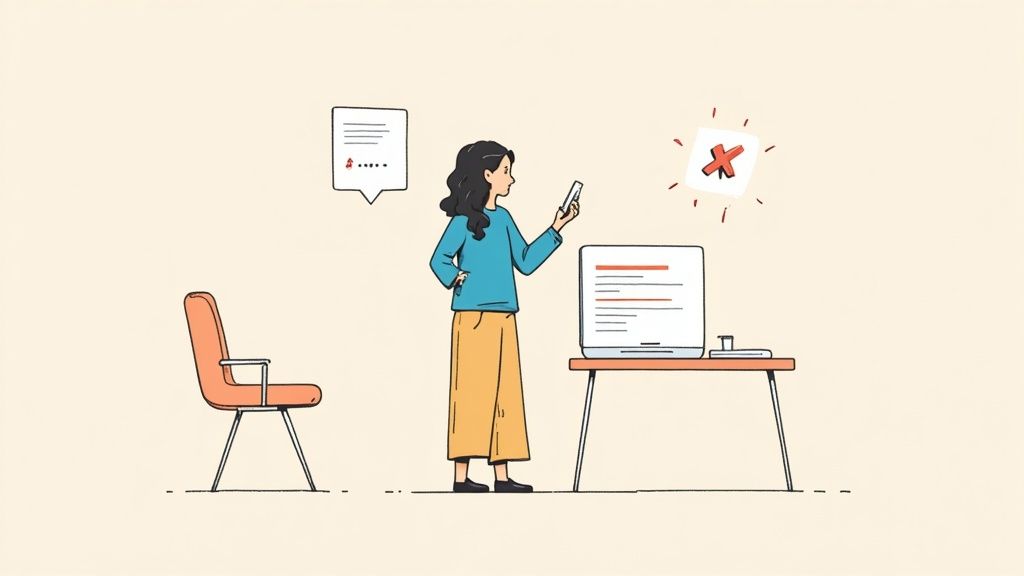A Guide on How to Improve Study Habits

Improving your study habits all boils down to one crucial shift: moving from passively reviewing information to actively engaging with it. If you're stuck re-reading notes or highlighting textbooks, you're likely working hard but not smart. It's a frustrating cycle that leads to burnout and poor results.
Why Your Current Study Habits Aren't Working
Let's be honest—spending hours staring at a textbook only to forget everything by morning is incredibly frustrating. Many of us fall into this trap, confusing the feeling of being busy with actual learning. The hard truth is that common study methods like re-reading, highlighting, and even summarizing are often passive and do very little to build lasting knowledge.
Your brain isn't a sponge that just soaks up information. Think of it more like a muscle that gets stronger through exercise. Passive review is like watching someone else lift weights at the gym—you see the action, but you're not building any strength yourself. To truly learn, you need to make your brain do the heavy lifting.
The Problem With Passive Learning
Passive learning is sneaky. It tricks you into a false sense of security that experts call the "fluency illusion." When you re-read a chapter, the text becomes familiar, and your brain mistakes that familiarity for genuine mastery. You think you know it, but you're really just recognizing it.
This is exactly why you can read a chapter five times and still draw a blank on an exam. You haven't built the neural pathways needed to retrieve the information when you need it most. To build those pathways, you have to practice pulling information out of your memory, not just cramming it in.
"The most pronounced difference emerged in alpha band connectivity, with the Brain-only group showing significantly stronger semantic processing networks.” This finding from an MIT study suggests that writing without AI assistance (a more active process) stimulates deeper cognitive engagement than relying on tools that make the work easier.
Embracing Active Engagement
This is where active learning changes the game. It’s a complete shift in your approach. Instead of being a passive recipient of information, you become an active participant in your own learning process.
Here’s what that looks like in practice:
Self-Quizzing: Constantly testing yourself on the material.
Teaching Concepts: Explaining a topic to someone else (or even just to your wall!).
Creating Connections: Linking new ideas to things you already understand.
These methods force your brain to retrieve and apply knowledge, which is how you form strong, durable memories. It's not just a theory, either. Research consistently backs this up; a comprehensive meta-analysis found a clear positive link between a student's study habits and their academic performance across different cultures and educational levels. You can explore the full findings on the correlation between study habits and achievement to see the data for yourself.
To give you a clearer picture, let's compare some common study habits.
Shifting From Ineffective to Effective Study Habits
It's easy to fall into passive habits because they feel easier. But the goal is to learn effectively, not just feel productive. Here's a quick comparison of passive techniques versus their active, more powerful alternatives.
Re-reading your textbook
Explaining concepts in your own words
Forces you to process and understand the material, not just recognize it.
Highlighting or underlining text
Creating flashcards or practice questions
Makes you actively retrieve information from memory, strengthening recall.
Summarizing a chapter
Drawing a concept map linking ideas
Helps you see the big picture and how different concepts connect.
Watching video lectures
Pausing to self-quiz on what was just said
Turns passive consumption into an active learning session.
Making this switch from passive to active study techniques is the single most important step you can take to improve your learning and get better results from your efforts.
Of course, if procrastination is what's holding you back, these active methods can feel even more daunting. Exploring some proven strategies to stop procrastinating can be a huge help here. Often, our ineffective habits stick around simply because we put off the more demanding—but ultimately more rewarding—active work.
This is where a tool like Obsibrain becomes so valuable. It’s not just another place to dump your notes; it’s a dynamic environment built from the ground up for active learning. For example, a student can use Obsibrain to transform passive lecture notes into active Q&A pairs using toggles, or link a new historical concept directly to a related event they learned about last semester. It’s designed to help you turn your study material into an interactive knowledge base, pushing you from passively consuming information to actively mastering it.
Building Your Academic Command Center

A solid study routine starts with a strong foundation. Let's be honest, improving your study habits isn't just about pure willpower; it's about building a system that actually works for you. This means creating a personalized academic command center where your plans, notes, and goals all live together in one organized space.
It’s time to move past vague intentions like "study more." Real learning happens when you set specific, measurable targets. Instead of a fuzzy goal, aim for something tangible: "Master Chapter 4 of Biology by Friday" or "Complete three practice exams for Statistics by next Wednesday." This simple shift in clarity turns overwhelming subjects into a series of manageable tasks.
This is where setting up your digital command center in Obsibrain comes in. The tool is designed to transform scattered notes and random to-do lists into an integrated system for success, giving you a clear, bird's-eye view of your entire academic world.
Architect Your Study Space in Obsibrain
Your first move is to give your knowledge a clear structure. In Obsibrain, that means setting up dedicated notebooks (or folders) for each class you're taking. This simple act of separation is surprisingly powerful—no more calculus notes getting lost in your history essays.
Think of a law student who uses Obsibrain to create separate notebooks for "Torts," "Contracts," and "Civil Procedure." Within each, they can create specific notes for cases, legal doctrines, and class lectures. This kind of organization makes finding information feel effortless, saving you from that frantic search for a critical detail you scribbled down weeks ago.
Next, you’ll want to layer on some tags. Think of tags as smart labels that help you categorize and connect information across all your different notebooks.
Here are a few I find incredibly useful:
#exam-topic: Slap this on any concept you know is fair game for an upcoming test.#difficult: Use this for ideas or problems that are giving you trouble and need another look.#research-paper: Tag any sources, quotes, or ideas for a specific writing assignment.#question: Mark anything you need to ask your professor or a study group about.
A medical student using Obsibrain could tag a complex physiological process with #difficult and #exam-topic. Before an exam, they can then generate a single view of all their high-priority, challenging concepts across different subjects, creating an instant, targeted study guide.
Identify Your Peak Performance Windows
Part of building a command center that works is understanding your own energy cycles. Are you sharpest in the morning, or do you hit your stride after dinner? Tracking your productivity helps you schedule your most demanding study sessions for when your brain is actually ready to perform.
Don't just guess. For one week, make a simple note at the end of each study block about how focused you felt. You might discover that you're a machine at memorizing vocabulary from 8 to 9 AM but are much better at creative problem-solving in the late afternoon. Obsibrain’s daily notes are perfect for this kind of quick, reflective journaling. A student can simply jot down "Felt focused during my 9 AM biochem review" or "Struggled with physics problems at 3 PM" to start seeing patterns.
A crucial element of knowing how to improve study habits is self-awareness. Scheduling demanding tasks like analytical writing during your peak hours and saving lighter tasks like organizing notes for your low-energy periods can dramatically increase your efficiency without requiring more time.
This strategy isn't about studying longer; it's about studying smarter by aligning your work with your natural rhythms. Obsibrain has built-in features perfect for this, and you can learn more about how to get started with its habits tracking functionality to build these routines directly into your system.
Construct Your Master Dashboard
With your notebooks and tags in place, the final step is to build a master dashboard. This is a single note in Obsibrain that acts as your mission control, providing an at-a-glance overview of your entire academic world.
Your dashboard can include things like:
A list of your current courses, with links to their main notebooks.
A summary of upcoming deadlines and exam dates.
Embedded queries that automatically pull in all notes tagged with
#exam-topicor#difficult.A simple checklist of your weekly study goals.
This central hub eliminates the mental clutter of trying to remember everything. It ensures nothing falls through the cracks and allows you to start each day with a clear, actionable plan. For example, an engineering student’s Obsibrain dashboard could show their project deadlines, links to their "Thermodynamics" and "Statics" notebooks, and a live-updating list of all notes tagged with #question to bring to office hours. Of course, building a strong command center also means equipping yourself with the right tech. To truly level up, explore some powerful AI tools for students to study smarter and see how they can integrate into your workflow.
By creating this structured environment, you shift from being a reactive student, constantly playing catch-up, to a proactive architect of your own success.
Turning Plans Into Consistent Daily Action

Having a killer academic command center is a great first step, but even the most brilliant plan collects dust without consistent action. This is where the real work happens—turning those big-picture strategies into the small things you do every single day. The secret to long-term improvement isn't about cramming in a few heroic study sessions. It's about building sustainable habits.
Think of it like building a bridge. One brick might not seem like much, but when you lay them one by one, day after day, you create something strong enough to get you where you need to go. It’s the small, repeatable actions that ultimately lead to big results.
From Intention to Action With Habit Tracking
The best way to make sure you follow through is to make your progress impossible to ignore. This is precisely where a dedicated tool like Obsibrain’s habit tracker shines. It lets you create specific, trackable commitments that tie directly back to your academic goals.
So instead of a vague goal like "study more," you create a concrete, measurable habit: "Review Spanish vocab for 20 mins." This tiny shift from a general goal to a trackable action makes the task far less intimidating and much easier to start.
Here’s how this plays out with Obsibrain in the real world:
A law student could track "Summarize one case daily." Every checkmark is a small win, building momentum for the next day.
A computer science major might use it to monitor "Complete one LeetCode problem." This turns a massive skill-building effort into a manageable daily routine.
A premed student could stay on top of dense material by tracking "Review one lecture summary before bed."
This works because you're focusing on the input (the daily habit) rather than getting fixated on the output (the final exam grade). When you consistently nail your inputs, the outputs tend to take care of themselves.
Building consistency is all about creating a system that reduces friction. When you define your study habits as clear, trackable tasks in Obsibrain, you eliminate the daily "what should I do now?" guesswork. You just open your dashboard and see exactly what needs to get done.
Integrating Daily Plans With Your Knowledge Base
Real productivity kicks in when your plans and your knowledge live in the same place. Bouncing between a calendar, a to-do list, and your notes is a surefire way to drain your mental energy. That's why connecting your daily schedule directly to your notes inside Obsibrain is so effective.
Right from your daily note in Obsibrain, you can link to the exact lecture summary you need to review or the specific practice problems you want to tackle. It creates a seamless workflow, tying your intentions directly to the materials you need. For a deeper look at how to structure your days this way, check out our guide on Obsibrain's daily planning features.
This integrated approach makes your study plan incredibly actionable. When your schedule says "Review Chapter 5 Quiz," you can click a link in your Obsibrain daily note and instantly jump to your notes, flashcards, and questions for that chapter. No friction, no wasted time.
The Power of Small Nudges
Let's be real—even with the best systems, motivation can be fickle. What’s interesting is that research shows even simple, low-effort nudges can make a huge difference. For instance, one study found that automated mobile interventions increased students' self-study time by an average of 32 minutes per day.
These weren't complex interventions; they were as simple as sending SMS messages and making one-minute calls to parents. It just goes to show that small reminders can produce big results. You can discover more insights about these study habit interventions and see how they were implemented.
While you probably won't be setting up automated calls, you can create a similar "nudge" system for yourself within Obsibrain. Setting reminders for key habits—like a daily pop-up for your "Review Spanish vocab for 20 mins" task—or scheduling a quick weekly review of your tracker provides that gentle push to stay on track. It’s all about creating a feedback loop that reinforces your commitment and turns a fragile new habit into an unbreakable routine.
If you want to get serious about learning, you have to stop passively reading your notes and start having a conversation with them. It’s the difference between information that goes in one ear and out the other, and knowledge that actually sticks. This is where two powerhouse techniques, active recall and spaced repetition, completely change the game.
Active recall is just a fancy term for pulling information out of your brain on purpose. Instead of just looking at the answer, you force yourself to remember it. Every time you successfully retrieve a piece of information, you strengthen the neural pathway to it. It’s like clearing a path in a dense forest—the more you walk it, the easier it is to follow next time.
This is the fundamental shift from being a passive consumer of information to an active learner.

This simple flow—question, summarize, retrieve—is how you turn reading into genuine understanding.
From Notes to Knowledge With Obsibrain
Obsibrain is practically built from the ground up for this kind of active engagement. Its whole structure of interconnected notes is perfect for turning your static lecture notes into a dynamic self-testing machine. One of the most straightforward ways to do this is by creating your own flashcards right from your study material.
Let's say a history student is reviewing a note on World War II in Obsibrain. Don't just highlight important dates. Turn them into questions. Instead of just highlighting "The Battle of Stalingrad ended on February 2, 1943," they can create a flashcard. The question: "When did the Battle of Stalingrad end?" The answer, of course, is "February 2, 1943."
What makes this so powerful in Obsibrain is the bi-directional linking. Your flashcard isn't just a floating piece of data; it's permanently tethered to the original note. If you get the answer wrong, you're one click away from the source lecture, where you can see the information in its full context and understand why you made the mistake.
Using Toggles for Complex Self-Quizzing
Flashcards are fantastic for discrete facts, but what about more complex ideas? For subjects like chemistry, math, or programming, you need to test your grasp of entire processes, not just isolated answers. This is where Obsibrain's toggle feature really shines as a self-quizzing tool.
Picture this: you're studying a tricky chemical reaction. In an Obsibrain note, write out the initial problem, then stick the entire step-by-step solution inside a toggle. With the toggle closed, it's just you and the problem. You're forced to work through it from memory. When you think you have it—or if you get hopelessly stuck—you can expand the toggle to check your work against the correct solution.
This method brutally exposes what you don't know. It’s incredibly easy to glance at a solved problem and feel confident, but the real learning happens when you try to reproduce the logic yourself. It's a low-stakes way to put yourself in an exam-like situation.
Implementing Spaced Repetition for Lasting Memory
Active recall becomes a true superpower when you pair it with spaced repetition. The idea is simple: you review information at increasing intervals over time. This technique strategically interrupts the brain's natural forgetting curve, pushing knowledge from fragile short-term memory into durable long-term storage.
You can set up a simple spaced repetition system right inside Obsibrain, either with a dedicated plugin or just a basic tagging system to schedule your reviews. A student could tag a new concept with #review-1. After they review it, they can change the tag to #review-2 and set a reminder for a week later, effectively building a manual but powerful spaced repetition system. Here’s a sample schedule to get you started.
Sample Spaced Repetition Schedule
This table provides an example of how you might structure your review intervals to fight the forgetting curve and lock in new knowledge.
First Review
24 Hours
Solidify the initial memory trace before it starts to decay.
Second Review
3-4 Days
Strengthen the memory and begin moving it to long-term storage.
Third Review
1 Week
Reinforce the concept after a longer forgetting interval.
Fourth Review
2-3 Weeks
Test long-term recall and cement the information.
Final Review
1 Month
Ensure the knowledge is deeply embedded and easily accessible.
Of course, you can and should adjust this schedule based on the material's difficulty and your own memory.
This approach is especially critical for students in demanding fields. It's no coincidence that between 2000 and 2020, enrollment in specialized math and computer science study abroad programs jumped by 258%. Students in these immersive, high-pressure environments rely on hyper-efficient learning techniques like spaced repetition to keep up. If you're curious, you can learn more about how immersive environments boost academic growth and see the data for yourself.
When you combine Obsibrain's active recall tools with a smart spaced repetition schedule, you're not just studying anymore. You're building a reliable system for mastering material for the long haul.
How To Refine Your Study Process Over Time

The best students I've ever seen don't treat their study plan like a static document. They know a good routine isn't something you just "set and forget." It’s a living, breathing process that demands regular tweaks and adjustments. This is the real secret to long-term academic growth and a critical part of learning how to improve study habits that actually stick.
This whole process is built on a single, powerful practice: reflection.
When you take a moment to step back and see what’s working (and what’s a total disaster), you can make smart changes instead of just barreling ahead with a broken strategy. It’s like the difference between navigating a forest with a map and just walking in a straight line, hoping you'll eventually find your way out.
Setting Up Your Weekly Review
Your weekly review is the most powerful tool you have for course correction. This is dedicated time to look at your progress, pinpoint what's causing friction, and set clear goals for the week ahead. Make this a non-negotiable appointment with yourself. Obsibrain is the perfect place to build this habit.
Let’s start by creating a new note in Obsibrain. Call it “Weekly Review Template.” This note will be your guide each week, making sure you ask the right questions. The idea is to go beyond just glancing at your grades and start digging into the process that got you there. A 2022 meta-analysis even found that taking short, strategic breaks improves focus—and a weekly review is the ultimate strategic pause.
Here’s a simple template you can build right in Obsidian:
Review Habit Tracker Data: Did I actually stick to my planned study sessions? Where did I slip up? In Obsibrain, you can view your habit tracker and get an honest look at habits like "20 mins Spanish vocab" or "Summarize one lecture."
Analyze Performance: Which topics felt like a breeze this week? Which ones felt like climbing a mountain? You can search for the
#difficulttag in Obsibrain to instantly see all the concepts that gave you trouble.Identify Challenges: What was my single biggest academic headache this week? Was it not enough time, a confusing concept, or just plain old procrastination?
Plan for Next Week: Based on all this, what's my number one academic priority for the coming week? What’s one tiny change I can make to my process?
This simple review transforms your routine from a mindless checklist into an intelligent system that learns and grows with you.
From Weekly Tactics to Monthly Strategy
Weekly reviews are for the tactical, in-the-trenches adjustments. Monthly reviews are for zooming out to see the big picture. This is where you assess your overall strategy. Are your core habits still serving you? Are you actually making progress toward your big semester goals?
The goal of a review isn't to judge past performance but to inform future actions. It’s a forward-looking process that transforms your study routine from a static checklist into a dynamic system of continuous improvement.
In Obsibrain, you can create a “Monthly Review” note and link to your four previous weekly reviews. This is how you spot the bigger patterns that are easy to miss on a week-to-week basis. You might suddenly notice you skip your Friday study session every single time, or that Chemistry keeps getting tagged with #difficult week after week. This view allows a student to realize "My current method for chemistry notes isn't working" and plan a strategic change.
Your monthly review should tackle the bigger questions:
Progress on Major Goals: How am I tracking against my big goals, like "Achieve an A in Chemistry"?
System Effectiveness: Is my note-taking system actually working for me? Am I using my tags in a way that makes sense?
Energy and Burnout: How am I feeling? Do I need to rejig my schedule to avoid hitting a wall?
By making these weekly and monthly check-ins a regular part of your routine in Obsibrain, you create a powerful feedback loop. You’re not just guessing; you’re analyzing your actions, finding knowledge gaps, and tweaking your approach based on real data. This habit of reflection is what separates the students who just work hard from the ones who work smart.
Common Questions About Improving Study Habits
Even with a great system, you're bound to hit a few snags. That’s a totally normal part of building better study habits. Let's walk through some of the most common questions and roadblocks I see students run into.
How Long Does It Really Take to Form a New Study Habit?
Let's get one thing straight: the whole "21-day" thing is a myth. Real, lasting habits don't just magically appear after three weeks. Research suggests it can take anywhere from two to eight months for a new behavior to become second nature. It all depends on you and how complex the habit is.
The secret isn't a short burst of intense effort; it's relentless consistency.
Start with a goal that's so ridiculously small you simply can't talk yourself out of it. Something like, "I will review my class notes for just 15 minutes today." Then, use Obsibrain’s habit tracker to watch your streak grow. There's something incredibly motivating about seeing that chain of checkmarks and not wanting to break it.
And if you miss a day? Don't sweat it. One slip-up doesn't erase all your progress. The real goal is long-term momentum, not short-term perfection. Just pick it back up the next day.
What Is the Best Way to Handle Constant Distractions?
You can't win the war against distractions with willpower alone. You need a strategy, and it starts with your environment.
First, become an architect of your focus space. That means putting your phone on silent and, more importantly, moving it to another room entirely. Out of sight, out of mind. Use a website blocker if you know you have a tendency to drift over to social media or news sites.
Next, give your brain a rhythm to follow. I’m a huge fan of the Pomodoro Technique for this. You work in a super-focused sprint for 25 minutes, then take a 5-minute break. This simple pattern trains your brain to lock in for short, manageable periods.
Inside Obsibrain, I recommend keeping a dedicated "Distraction List" note pinned somewhere handy. The moment a random thought or "I need to remember to..." idea pops into your head, just dump it there. A student studying for an exam can quickly type "email financial aid office" into their Distraction List note in Obsibrain and immediately return to their work, knowing the thought is captured and won't be forgotten.
Think of distractions as leaks in a bucket. You can try to carry water faster (work harder), or you can patch the leaks (manage your environment). The second approach is far more effective and less exhausting in the long run.
Can I Integrate Obsibrain With Other Study Tools?
Yes, and you absolutely should! A truly smart workflow isn't about finding one single app that does everything. It's about using Obsibrain as your central command center—the hub that connects all your other specialized tools.
For instance, a lot of students swear by dedicated flashcard apps like Anki for its powerful spaced repetition algorithm. You can easily drop links to your specific Anki decks right inside your relevant Obsibrain notes. This gives your flashcards context. For example, your Obsibrain note on "Cell Mitosis" could contain a direct link to your "Mitosis Anki Deck," stopping your study materials from getting scattered all over the place.
You can also embed PDFs of research papers, link to Google Drive folders for group projects, or connect to just about any other tool with a web link. The idea is to make your system frictionless, with Obsibrain acting as the glue that holds it all together.
If you have more specific integration questions, our comprehensive FAQ documentation is a great place to look.
Should I Study Alone or Is a Group Better?
This isn't an either/or question. The answer is both. Solo study and group study serve completely different—but equally important—purposes.
Solo study is non-negotiable for the initial learning and deep memorization phase. This is your time for focused work: reading the material, creating your notes, and using active recall techniques inside Obsibrain. You have to build that foundational knowledge on your own first. For instance, you could use Obsibrain to create summary notes and self-quiz toggles for a chapter before meeting with your group.
Group study is where you test and sharpen that understanding. Use these sessions to explain concepts to other people. It's one of the fastest ways to find out what you don't actually know. You can also debate complex ideas and work through tough problems together, which helps solidify the material in a different way. A great use case is having each group member take a concept from an Obsibrain shared note and teach it to the others.
The best approach? Master the material on your own, then sharpen it with your peers. To dig deeper into this, you can explore other great methods to study smarter not harder, which is all about getting better results without just piling on more hours.
Last updated
Was this helpful?